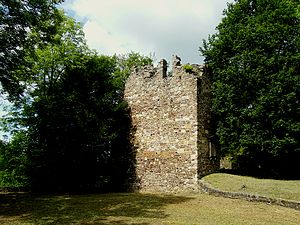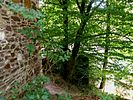Itterburg
| Itterburg | ||
|---|---|---|
|
Itterburg ruins |
||
| Creation time : | around 1126 | |
| Castle type : | Höhenburg, spur location | |
| Conservation status: | Wall remains | |
| Standing position : | Nobles | |
| Place: | Vöhl - Thalitter | |
| Geographical location | 51 ° 13 '16.7 " N , 8 ° 53' 44.5" E | |
| Height: | 375 m above sea level NHN | |
|
|
||
The Itterburg is the freely accessible ruin of a hilltop castle on an elongated 375 m above sea level. NHN high ridge north above Thalitter , a district of the Hessian community Vöhl in the Waldeck-Frankenberg district . It is one of the three so-called Itterburgen , to which the Steuerburg and the Upper Castle also belong.
history
In the year 793 the "main courtyard Ittera" in Ittergau was first mentioned in a document. Probably at the same place the lords of Itter built the Itterburg in the 11th century. It is mentioned for the first time in 1126 when the sisters Riclind and Frederun von Itter, nieces and heiresses of Folkmar von Itter, who died in 1123, entrusted the allodial parts of the Itter estate to Abbot Erkenbert von Corvey as a fief . Around 1190, Archbishop Philip I acquired the castle with 200 hooves from Wittekind II von Schwalenberg for 200 marks for the Cologne Archdiocese . The von Itter gentlemen subsequently asserted themselves between their far more powerful neighbors by becoming dependent on them and thus also protecting them in several ways. Heinrich III. von Itter the Itterburg to the Hessian Landgrave Heinrich I and received it back from him as a castle loan. Heinemann III. von Itter allowed the Archbishop Heinrich III. of Mainz and his successors opened the castle to all enemies of the archbishopric, with the exception of Landgrave Heinrich II.
The last Herr von Itter to live in the castle, Heinemann III. († 1356), is said to have been stabbed there by one of his relatives - which was alleged by ancient historians, but has not been documented.
At that time the following places belonged to the Itter rule : Dorfitter , Thalitter , Obernburg , Hof Lauterbach , Oberwerba , Vöhl , Basdorf , Asel , Marienhagen , Herzhausen , Harbshausen , Kirchlotheim , Schmittlotheim , Altenlotheim , Ederbringhausen , Niederorke , Oberorke and Buchenberg .
After the death of Heinemann III. In 1357 the Archbishopric of Mainz and the Landgraviate of Hesse jointly took possession of the much larger part of the Itter rulership and each paid his widow Margarethe 900 marks of solder for it. In 1359 Mainz pledged its part of the rule to Count Otto II von Waldeck , who pledged it to Thile Wolff von Gudenberg in 1381 . In 1383 the Hessian landgraves also pledged their part to Thile, with which the castle and almost the entire Itter rule came into his pledge possession. Thile then moved his residence to Vöhl , where he had a castle built south of the village, which later became Vöhl Castle .
In 1542 the Waldeckers redeemed their pledge, and in 1562 the Landgraves of Hesse too. In 1567, the Itter rule came with the Itterburg when the Landgraviate of Hesse was divided under the sons of Philip I to Philip II of Hesse-Rheinfels . After his death in 1583, the Itter rule and the now unused castle passed to his brother Ludwig IV of Hesse-Marburg , who subsequently also acquired the parts of the Itter rule that had not previously been landgrave.
The castle fell into disrepair as early as the middle of the 15th century after the Wolff had moved from Gudenberg zu Itter to Vöhl, and was completely destroyed in the Thirty Years War . George III (1632–1676), the second son of Landgrave Georg II of Hessen-Darmstadt , received the former rule of Itter as Paragium after the death of his father in 1661 . He resided on the Lauterbach farm north of Vöhl and in Vöhl Castle and also wanted to develop the Itterburg into a residence, but died before the work was finished. The remains of the castle came into the private property of the mining inspector Ludwig Balthasar Müller in Thalitter in 1715 as a gift from Landgrave Ernst Ludwig .
In 1815 the former King of Sweden, Gustav IV Adolf , who was deposed in 1809 and who lived in Switzerland , bought the ruins and now called himself Herr or Graf von Itterburg at times. His son, the Austrian Lieutenant Field Marshal Gustav Prince von Wasa , owned the ruins from 1837. Extensive excavations were carried out from 1820 and the remaining building material was exposed again. In 1951 the municipality of Vöhl bought the castle grounds for 18,000 DM .
investment
The Itterburg was a fort with a square floor plan within an oval kennel . The presumed keep - residential tower had a floor area of 11 × 11 meters and a wall thickness of 2 meters. The total area is about 8 hectares . Significant remains of the wall of the residential tower have been preserved today.
literature
- Rudolf Knappe: Medieval castles in Hesse - 800 castles Castle ruins and fortifications . 3rd edition, Wartberg Verlag, Gudensberg 2000, ISBN 3-86134-228-6 , pp. 148-149.
- CF Günther: Pictures from the Hessian prehistory: With 51 plates illustrations , therein: The Itterburg with the Steuerburg and the Obernburg , Jonghans, Darmstadt, 1853, pp. 334–344.
- Rolf Müller (Ed.): Palaces, castles, old walls. Published by the Hessendienst der Staatskanzlei, Wiesbaden 1990, ISBN 3-89214-017-0 , p. 348f.
Web links
- Itterburg, Waldeck-Frankenberg district. Historical local lexicon for Hesse (as of September 7, 2012). In: Landesgeschichtliches Informationssystem Hessen (LAGIS). Hessian State Office for Historical Cultural Studies (HLGL), accessed on November 8, 2012 .
- Itterburg on an old color map from 1768
- Itterburg picture gallery, near Burgenwelt
- Castles and palaces in the Waldeck-Frankenberg district, at the castle inventory
Notes and individual references
- ↑ The name Steuerburg , which is occasionally mentioned , does not refer to the Itterburg, but to a former small outbuilding, and the name Löwensteiner Burgsitz , which is also often used, refers to a residential building immediately south of the actual Itterburg that was demolished in the 16th century.
- ^ "Itterburg, Waldeck-Frankenberg district" (property). Historical local dictionary for Hessen. In: Landesgeschichtliches Informationssystem Hessen (LAGIS).
- ↑ Heinemann's brother Adolf and his descendants still owned smaller parts of the estate until the death of Erasmus von Itter in 1443.
- ↑ Castle remains - castles and palaces in the Waldeck-Frankenberg district ( Memento of the original from September 27, 2007 in the Internet Archive ) Info: The archive link has been inserted automatically and has not yet been checked. Please check the original and archive link according to the instructions and then remove this notice.
- ↑ So u. a. in 1588 the tax castle near Thalitter from the Lords of Löwenstein, a branch of the Lords of Löwenstein . ( Christoph von Rommel: History of Hessen, Volume Five. Perthes, Kassel, 1835 (p. 641) )
- ↑ The surrounding area, a pasture area of about 3 hectares, belonged to the Thalitter dairy and was used by them.









